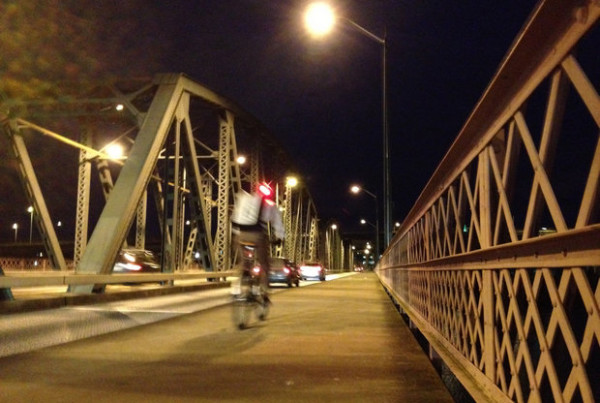The Nation: The Rise of Urban Biking
Ben Adler
September 27, 2011 | This article appeared in the October 17, 2011 edition of The Nation.
Residents of American cities and college towns may have noticed a growing urban species whizzing down their streets. One strand of the highly adaptive Homo pedalis can be identified by telltale markings: a single leg of skinny jeans rolled up, a plaid shirt unbuttoned to alleviate perspiration and a clumsy retro helmet. As many young professionals choose cities over suburbs, the rising cost of living has pushed newcomers to the fringes of the urban core. Mass transit is not always available or convenient. Driving is costly and time-consuming. So young urbanites, like people nationwide, have turned to bicycles; bike use has gone up 39 percent nationally since 2001, according to the League of American Bicyclists. In the seventy largest US cities, commuter bike use is up 63 percent. “The cities are seeing huge rises [in cycling],” says Jeffrey Miller, executive director of the Alliance for Biking and Walking. “San Francisco has been seeing a massive increase, Chicago is seeing huge numbers, DC is seeing huge increases.”
The urban biking surge can be linked to a number of other factors, from high gas prices to an increased awareness of climate change. New bicyclists have discovered how unsafe many roads are for riding—and in response they have helped reinvigorate a movement that was once the sole province of urban planners and environmentalists: to reshape America’s streets.
In 2005 the National Complete Streets Coalition was born. A spinoff of America Bikes, the national nonprofit “advocating for positive outcomes for bicycling in the federal transportation bill,” Complete Streets has taken this mission and broadened it to advocate for the needs of all users at state and local levels. “A true complete streets policy must apply to everyone traveling along the road,” the group says on its website, as part of a recommended list of “ten elements of a comprehensive complete streets policy.” Rather than emphasize potentially divisive questions of lifestyle or environmental impact, the primary selling point is safety: making sure drivers and nondrivers alike, especially children and the elderly, can use streets safely, on foot or bicycle. Complete streets legislation has been passed in seventeen states—and at least eighty-one jurisdictions—most recently New York, where the law was dubbed Brittany’s Law, after a 14-year-old girl who was killed by a car on the way to school in Wantagh, on Long Island. Her mother was part of the coalition that lobbied for the law and included AARP, one of the Complete Streets Coalition’s primary members. The new law stipulates that complete streets design principles must be taken into consideration by the New York State Department of Transportation when overseeing or undertaking new projects.
For decades traffic engineers saw their purpose as simply moving cars, a perception that has not entirely changed. “There are some departments of transportation that still very much see that they only have this one role,” explains Complete Streets executive director Barbara McCann. Complete streets legislation has been pushed primarily by groups seeking alternatives to cars. Bills like the one passed in New York require transportation agencies to consider how they will move not just cars safely and efficiently but also pedestrians and bicyclists. This could mean wider sidewalks, more bike lanes, fewer car lanes or other traffic calming measures. In June the Association of American State Highway and Transportation Officials approved the first new routes in more than thirty years for a planned national network of bike routes. Biking activists deserve much credit for this shift. “The complete streets movement started with biking, but is much broader than that,” says McCann. “The big engine has been the bike community.”
Who is this community? The popularity of biking among creative-class professionals has given rise to the impression among some that bicycling—which is cheaper than driving or even mass transit—is the preoccupation of a narrow set of city residents. “These bike lanes are elitist, and they only serve a few people,” said a neighborhood representative at a public meeting last year to discuss bike lanes that would connect South West and South East Washington, DC. It’s certainly true that many of the bikers pedaling around the hipper city precincts appear to be of the bourgeois-bohemian persuasion. But take a look across the country and bicyclists are a diverse lot, including immigrants who lack the documentation to get a driver’s license and people who are too poor to own a car. These are disproportionately minorities. According to a 2006 report by the Brookings Institution and the University of California, Berkeley, 19 percent of blacks live in households without a car, compared with 13.7 percent of Hispanics and 4.6 percent of whites.
“There’s a populism inherent to [biking],” says Michael Murphy, a spokesman for Transportation Alternatives, a New York City group. “Most of the people I see biking where I live in Queens are not flannel-wearing hipsters; they are working-class people just getting around town. It’s a transit choice more than a lifestyle choice.”
Still, the perception that cycling advocates are elitist has been exploited politically. Conservatives who dismiss smart-growth advocacy as the work of out-of-touch liberals who don’t realize that Americans will never get out of their cars have ramped up their criticisms to the point of demagogy, painting the complete streets movement as a scheme to turn red-blooded Americans into socialists. Last year, Colorado’s Republican gubernatorial nominee, Dan Maes, attacked his Democratic opponent, Denver’s mayor, John Hickenlooper, for building bike lanes, warning that they “could threaten our personal freedoms” and “convert Denver into a United Nations community.” Hickenlooper won.
Conservatives have not always been so irrational. In 1965 William F. Buckley Jr. ran for mayor of New York on the Conservative Party line, on a platform that included bike lanes. Even Paul Weyrich, co-founder of the Heritage Foundation and the American Legislative Exchange Council, supported public transportation. Today Ohio Republican Steve LaTourette is a co-sponsor of federal complete streets legislation, and Tim Pawlenty signed complete streets legislation in Minnesota as governor. Bike lanes are not inherently liberal or conservative; they are just good, pragmatic governance. (In fact, a true conservative would oppose our current practice of distorting the free market by subsidizing cars over other forms of travel.)
But like mass transit, biking tends to fare better under Democratic governments. At the federal level, House Democrats would have included complete streets language in their version of the Surface Transportation Reauthorization bill, which provides federal funds for maintaining and safely operating roads and mass transit systems and is supposed to be reauthorized every six years. (The most recent one expired in 2009.) The Republican version of the bill is far less friendly to bicycles and mass transit, and there is no complete streets component.
Even in liberal strongholds like New York City, not everyone has been happy to adapt to complete streets initiatives or their precursors. Beginning in 2007, under Transportation Commissioner Janette Sadik-Khan, the city added 250 miles of bike lanes and protected routes. Today, twice as many New Yorkers commute to work by bike as in 2005. This would seem to be good news, yet Sadik-Khan’s predecessor as commissioner, Iris Weinshall, who is married to Senator Chuck Schumer, was criticized for appearing to support her Brooklyn neighbors in March when they sued to remove a bike lane painted on her street, Prospect Park West. John Cassidy, a staffer for The New Yorker, wrote a blog post in sympathy, complaining that he can no longer find street parking in Manhattan and comparing “the bicycle lobby” to Jacobins.
In 2009 bicycle activists found themselves pitted against the large Hasidic Jewish community in Williamsburg, Brooklyn, when community leaders objected to a newly painted bike lane running through their neighborhood. Although they cited safety as the reason, at least part of their objection stemmed from their perception that the women on bikes were immodestly dressed, which only added fuel to the controversy. Mayor Michael Bloomberg, likely with votes in mind, caved to their pressure and removed the bike lanes. Activists surreptitiously repainted them a few nights later; a video of them doing it went viral on YouTube.
Where safety is concerned, the backlash seems more justifiable. A study released in September found that 1,000 pedestrians are injured by cyclists in New York State every year, with New York City accounting for roughly half of that figure. The findings bolstered longtime complaints that New York bicyclists routinely run red lights and bike illegally on sidewalks. Responding to such concerns—or perhaps just to raise money for the city in tough fiscal times—the New York Police Department last year began aggressively ticketing bicyclists for traffic violations. Bicycle advocates have complained that bikes are unduly targeted relative to cars. Transportation Alternatives responded to the study by pointing to the 70,000 New Yorkers injured by cars each year, but they concede that cyclists might win more allies if they learn the laws and follow them. “A lot of people in New York are new bicyclists,” says Murphy. “Their last memory of biking is as children when no laws were applied to them. They can’t follow laws they don’t know.”
Regardless, if New York is a guide, another bike on the street is undoubtedly safer than another car. In the past five years 766 pedestrians were killed by cars in New York City, compared with three pedestrians killed by bicyclists. Transportation Alternatives points to figures showing that adding a bike lane to a street reduces all collisions and injurious crashes—not just those involving bikes—by up to 40 percent.
In September the Bloomberg administration announced a deal with Alta Bicycle Share to introduce a bike-sharing program similar to those in other cities. Six hundred “bike stations” will be placed around town, and users will be able to rent a bike for the day for a nominal fee, returning it to any rack in the city. Programs like this have worked best when accompanied by safety education measures; in Minneapolis, which received a $25 million federal grant in 2005 to promote bicycling and bike safety in schools and offices, car-on-bicycle accidents have dropped 20 percent since 2000, even as bike use has risen.
Such grants, however, may not be renewed under the Republican transportation bill. As the Complete Streets Coalition has shown, the road to success will likely be forged at the grassroots level. When it comes to combating greenhouse gas emissions, obesity and other hazards of modern life, bike lanes are not a panacea. But they’re a good place to start. Eventually, they can help reshape not just our concept of the city and its streets but the way residents define themselves. Says Transportation for America spokesman David Goldberg, “There’s a younger generation that doesn’t automatically assume that paying for a car and using it for everything is the only way to live life.”

